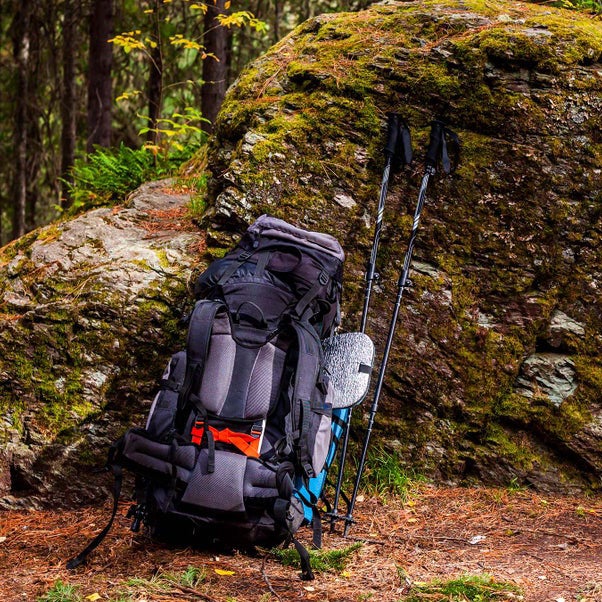Taking your first steps into the world of hiking? Let us be your guide. Our Backpacking 101 course on Outside Learn will teach you everything you need to know, with expert hiker and backcountry guide Siena Fry walking you through everything from assembling your kit to picking a campsite to cooking in the backcountry.
A backpacking trip can be the experience of a lifetime—as long as you’re properly equipped. Using a checklist is the best way to take stock of your kit before heading out. Our handy list covers the essentials for anything from an overnight to a week out in the wilderness. This list is meant for three-season trips in temperate landscapes only—you’ll need additional or different gear for special adventures like winter camping, desert camping, or thru-hiking. Time to get packing! For a printable PDF checklist, click here. Taking a shorter trip? Our day-hiking checklist has you covered.
More: Get the basics of hiking and camping with our Backpacking 101 course on Outside Learn.
Backpack
- Typically 50 to 80 liters of capacity
- Rain cover or waterproof pack liner
- Waterproof compression sacks or storage sacks (optional)
For three-season backpacking trips of a weekend or longer, you should carry a pack between 50 and 80 liters. If you’re simply doing an overnight trip or have an ultralight kit, you can make do with a smaller pack. There are many considerations when choosing a backpack, including carrying capacity, features like sleeping-bag compartments and ice-ax fasteners, pockets, materials, and overall fit. Read more about properly choosing and packing a backpack here.
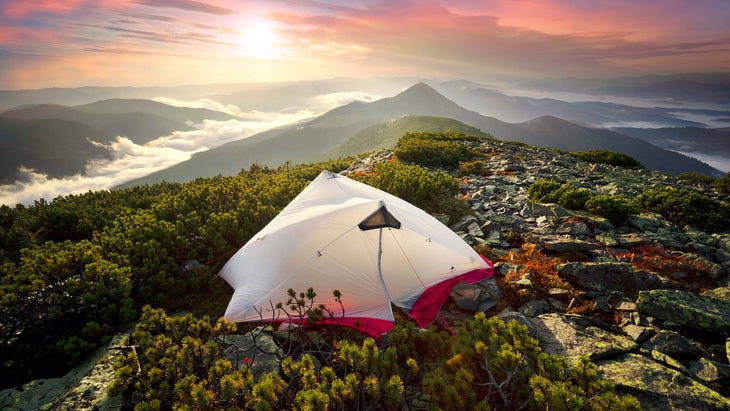
Shelter
- Tent, tarp, or hammock
- Rain fly
- Poles
- Stakes
- Trekking poles (optional, can be used if necessary to pitch certain shelters)
- Groundsheet (optional)
Tents are the most beginner-friendly shelters, and they offer the best combination of living space and protection. Hammocks can be comfortable in warmer weather below treeline but may require extra time for setup and tree selection, along with extra equipment like a tarp to protect against rain or an underquilt to guard against cold. By themselves, tarps save weight and space but lack protection against bugs and take time and consideration to pitch correctly. Make sure to take stock of every pole and stake before setting off. Read more about choosing the right tent here.
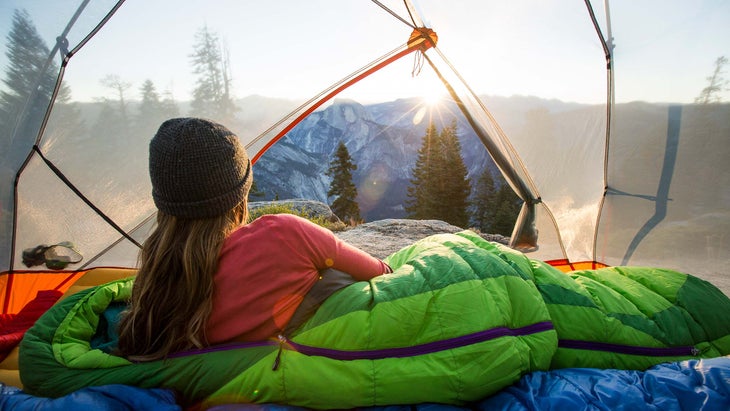
Sleep System
- Sleeping bag or quilt (rated 15 to 30 degrees)
- Sleeping pad (foam, self-inflating, or inflatable with an R-value of 2 or higher)
- Camping pillow (optional)
Traditional mummy bags offer a good warmth-to-weight ratio compared to rectangular sleeping bags while offering more coverage than quilts. Quilts can provide great weight savings as long as you bring a beanie or detachable hood for warmth, but they can take some getting used to. Every sleeping bag has a temperature rating indicating the lowest temperature at which it’ll keep you comfortable. In warmer climates, like parts of the American Southwest, you can get away with a higher comfort rating. Your bag is only as good as your pad, so make sure it has the appropriate insulating R-value for your lowest expected temperature (normally a 2 to 5 R-value for three-season camping; 5 or above in winter). Read more about choosing a sleeping bag here.
Water Filtration and Storage
- Water bottle or reservoir
- Purification system (squeeze, pump, gravity, or press filter, or a UV purifier)
- Backup filtration system (chemical purification tablets or drops, or a small secondary filter)
Every filter or purifier, regardless of style, will eventually clog up; always bring the tools required to clean your filter. If using a UV purifier, bring a mesh pre-filter for sediment if you expect anything but pure mountain water. If there’s a chance of freezing temperatures, place your filter in a leakproof bag and stash it in your sleeping bag overnight—if it freezes it is no longer safe to use. Read about some of our favorite water filters here.
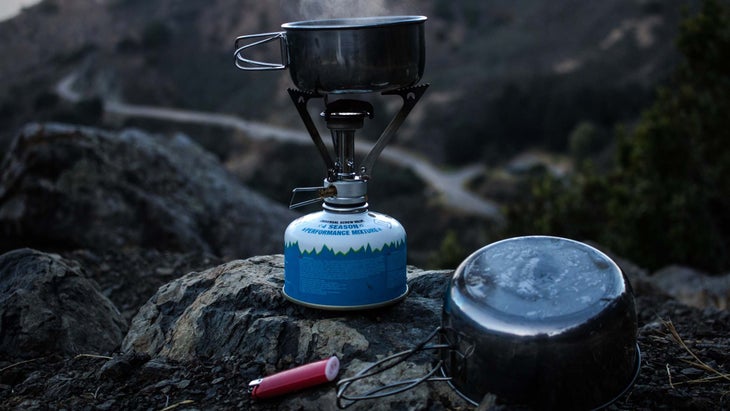
Stove and Cookware
- Stove (canister, liquid-fuel, or other style)
- Fuel (isobutane or propane canisters, liquid fuel, or alternative fuel)
- Lighter or waterproof matches
- Pots if they’re not integrated into the stove system
- Utensils
- Cleaning rag or mini sponge
- Mug (optional)
- Biodegradable soap (optional)
Canister stoves are great for quickly boiling water to rehydrate food, kill microbes, and make hot drinks. Choose a stove with a wider burner head and a non-integrated pot for easier backcountry cooking. Many backpackers opt for canisters for their ease of use, but liquid-fuel stoves can be more efficient in cold temps and at higher altitude, and they accept multiple types of fuel. Read about some of our favorite camp-kitchen equipment here.
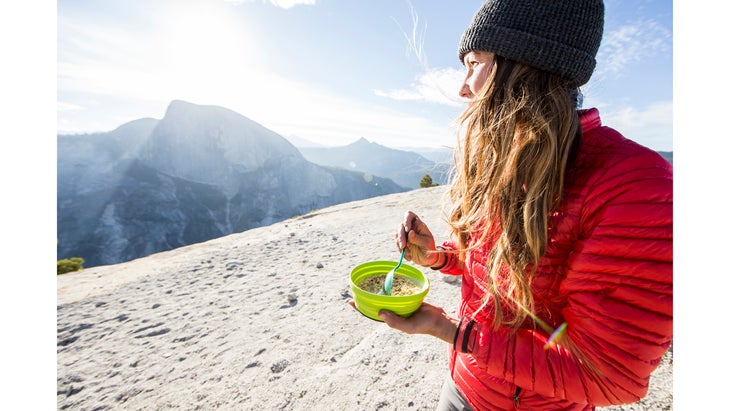
Food and Snacks
- Enough food for each day of your trip based on your caloric needs, plus an extra day’s worth in case of emergency
- Snacks to stave off hunger and fuel your hike
- Hydration/electrolyte powder or tablets (optional)
- Bear canister (if required), Ursack-type bag, or 50 feet of nylon cord and a carabiner for a hang if you’re in bear country
Deciding how much food to bring comes down to personal physiology, pace, and trail conditions, although 2,000 to 5,000 calories per day is a rough range for many people. Packing calorie-dense foods like nut butter, cheese, and olive oil will help you save weight. When in doubt, pack more food than you think you’ll need.
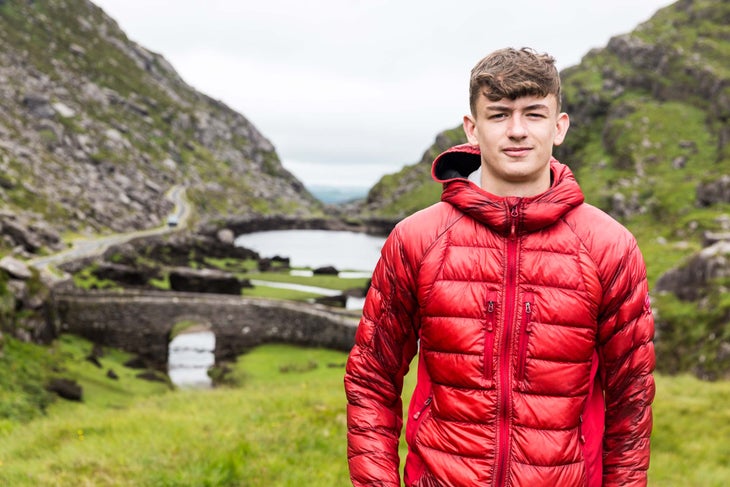
Clothing
- At least two pairs of socks
- At least two pairs of underwear
- Shorts, pants, or other bottoms such as a skirt or kilt
- T-shirt
- Long-sleeve shirt (for protection from insects and sun)
- Insulating midlayer, such as a fleece or light puffy
- Packable down jacket
- Hard-shell jacket or rain poncho
- Warm beanie
- Sun hat
- Sunglasses
- Top and bottom base layers (optional)
- Light gloves or liners (optional)
- Rain pants (optional)
The saying “Cotton kills” is popular among hikers for a reason: the material holds on to moisture and doesn’t insulate when wet—the perfect recipe for hypothermia. Wear only wool or synthetic layers for the best temperature regulation. Base layers and gloves can be lifesavers in cold or high-altitude climates but overkill in warm, low-elevation climates. Bring adequate rain gear even if precipitation isn’t in the forecast, and always stash at least two pairs of socks (wet feet means a miserable trip). Read more about dialing in your layering system here.
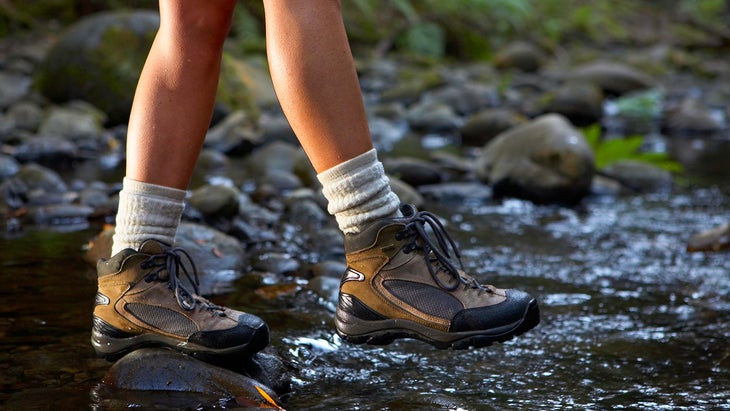
Footwear
- Hiking boots, hiking shoes, trail-running shoes, or hiking sandals
- Camp shoes or sandals (optional)
- Gaiters for snow or scree (optional)
Choosing hiking footwear is one of the most subjective decisions a hiker can make—there are fits and options for every hiker and hiking style out there. For stability under heavy loads and over rough terrain, and for better durability, midcut or high-top boots are a safe choice. Trail-running shoes will help you move faster (a pound on your feet is equivalent to five pounds on your back) and tend to breathe better. Depending on how much weight you’re carrying, lighter shoes can be more comfortable over long distances in general. Some backpackers prefer to hike in sandals for breathability, lightness, and easy water crossings, but those folks must contend with the potential for cold feet and stubbed toes. Read more about how to choose the perfect footwear here.
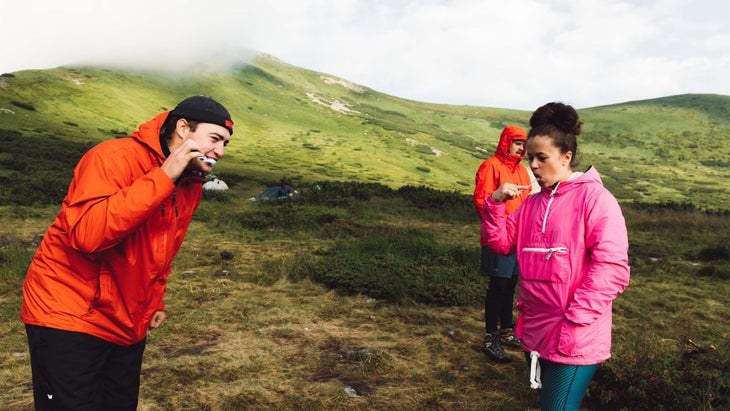
Personal Hygiene
- Trowel
- Toilet paper
- Hand sanitizer
- Sunscreen and SPF lip balm
- Bug repellent
- Toothbrush, toothpaste, floss
- WAG bag (if required)
- Menstrual products and pack-out bags (if not using a menstrual cup)
- Female urination device (optional)
- Pee rag (optional)
How you take care of business in the backcountry depends on the environment. The easiest scenario involves moving at least 200 feet from any water source, trail, or camping area, digging a six-to-eight-inch-deep hole, clearly marking your spot, and cleaning your hands thoroughly. In certain environments—such as deserts or tundra—or protected and popular parks, a WAG bag (for “waste alleviation and gelling”) may be required. And remember: tampons are always a pack-out item. Read more about backcountry hygiene here.
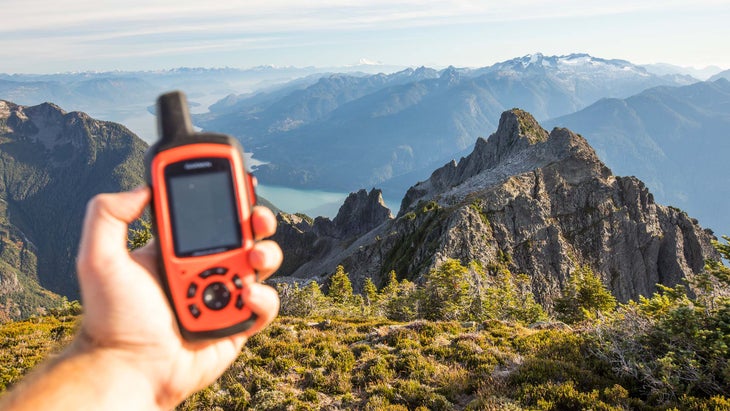
Electronics
- Power bank or solar charger with cables (optional)
- Headlamp with extra set of lithium batteries
- Satellite messenger or personal locator beacon (optional)
Most hikers can get away with a small power bank to charge their phone and headlamp on a backpacking trip. On extended trips with no resupply, a solar charger is the best (albeit slow) solution. Remember to keep batteries in your sleeping bag at night—and always lithium, never temperature-sensitive alkalines, which lose juice more quickly as the mercury drops. Read about some of our favorite backcountry electronics here.
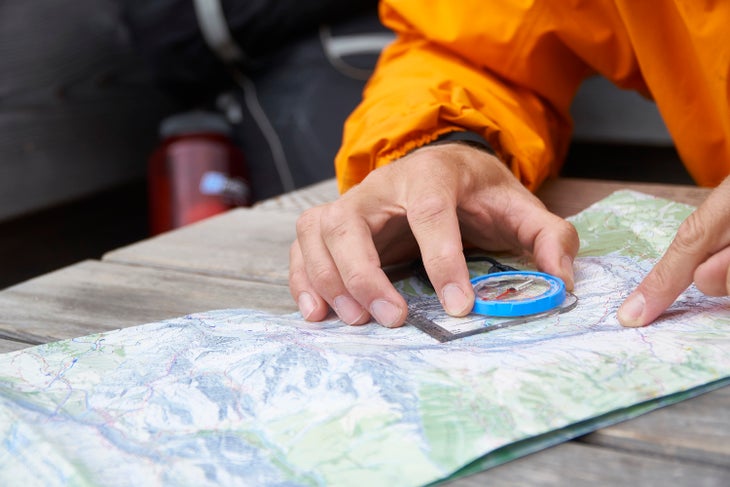
Navigation
- Map, compass, and the knowledge to use both
- GPS device (optional)
- Navigation app, like Gaia GPS (optional)
Always carry a topographic map and compass and know how to use them. GPS devices and smartphone apps are great tools, but they can run out of power or malfunction. Peace of mind requires carrying only a few extra ounces and the know-how from a quick navigation course. Read more about backcountry navigation here.
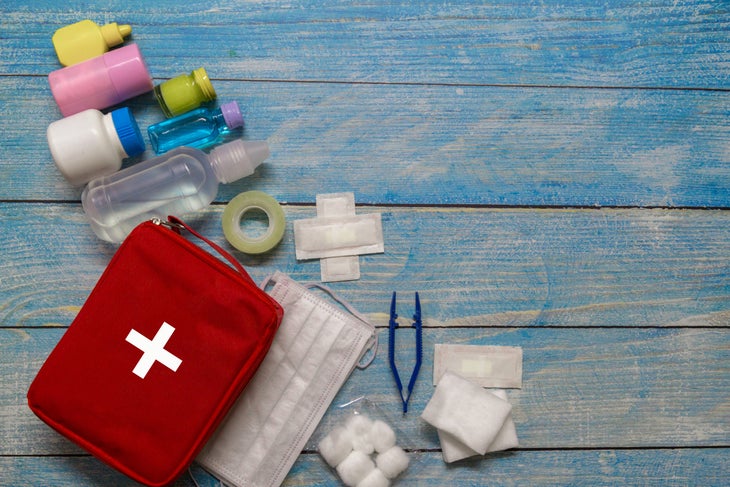
Repair and Emergency
- First-aid kit
- Prescription medication
- Moleskin
- Knife or multitool
- Bear spray (in grizzly country)
- Duct tape
- Patch kit for sleeping pad
- Waterproof matches or fire starter
You can easily buy a first-aid kit that has everything you need (and more), or simply grab a waterproof bag and raid your own medicine cabinet or pharmacy for a low-cost alternative. Duct tape is one of the most useful all-purpose tools you can carry, and it can help with medical emergencies as well as gear repair. Sleeping-pad patch kits are especially important if you’re sleeping on rough ground. Read more about building emergency kits here.


